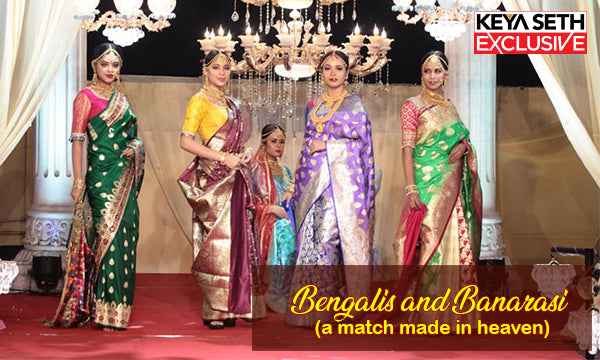India is famous globally for its enriched ethnic wear, exceptional heritage, and culture. Saree is one of the popular ensembles and the oldest unstitched garment, worn by Indian women. It is widely preferred by women of all ages because of its distinguished fashion statement while giving a traditional touch. Indian festivals are incomplete without wearing a saree. From aristocrat to a simple woman, saree is favored by all. Saree is known to hold and carry the dignity of Indian culture, besides it is equally fashionable too due to its varied draping styles.
SILK- THE ROYAL FABRIC
The most demanding and delightful fabric among all saree types is silk. In India, Silk is generated by Tasar Silkworm, Mulberry Silkworm, and Muga Silkworm. The popular silk producing states of India are Assam, Chattisgarh, Karnataka, Andhra Pradesh, Tamil Nadu, and West Bengal. Explored in almost all provinces, silk saree came up in different manifestations across the country. It can glorify any culture with its royalty and richness. Be it conventional rituals, weddings, or any traditional celebrations, silk sarees compliment the beauty of special moments. It is considered grand and no Indian women's wardrobe is complete without a silk saree. Indian silk sarees are considered auspicious and sacred for which it can be the best gift for your loving ones or even it is offered to goddesses.
The past of Silk Saree
The origin of the saree seems to date back to the period when civilization was established. History says that women in the Indus valley civilization used to wear a long piece of cloth to cover them. The present age saree we wear is the result of the evolution of clothes they used to wear. China is said to be the first country to develop silk. Silk sarees are also known to have a connection with the Persian and Mughal influence of Indian culture. A combination of foreign customs and indigenous weaving techniques has given rise to indifferent arts presented in saree. Most Indian region is found to develop their native silk sarees. Either handloom or power loom, some are prepared from pure silk and some are blended with silk fiber. We clubbed together some of the well-known silk sarees are have enlisted here:
- Chanderi Silk- It is favored by women due to its lightweight, fine texture, and luxurious feel. This fabric is created by weaving silk with golden zari and is woven in traditional cotton yarn. Madhya Pradesh is the state of origin of this saree. These are available in innumerable colors, intricate designs, and varied textures.
- Banarasi Silk- These are originated in the holy city of Varanasi, and can be easily recognized due to their elaborated silver or golden zari work and opulent embroidery. Crafted from the highest grade of silk fabric they spread an essence of artistic brilliance. Golden zari threads created from gold alloys make the motifs on the silk body of the saree which gives the saree the appropriate position to be worn in royal gatherings. West Bengal became one of the highest purchasers of Banarasi sarees as adorning a Bengali bride is incomplete without a Benarasi saree. Katan silk goes hand in hand with Benarasi silk, as these are equally sophisticated, unique, and elegant preferred by young generations.
- Kanjivaram Silk- Kanjivaram got the name from the Kanchipuram region of South Indian state, Tamil Nadu. Created by skilled craftsmen, these sarees are regarded as auspicious and are worn on special events and occasions. The intriguing fact about this saree is the pallu and the border which differentiates in hue from the rest of the saree. The body of such sarees is festooned with zardosi motifs.
- Bhagalpuri silk- Also known as Tassar silk, bhagalpuri silk is originated in the ‘silk city’ Bhagalpur of Bihar. This is a dying technique of Silk sarees and is produced in mulberry orchards. Featured with advanced quality and intrinsic artwork, it attracts buyers across the globe. It is artfully woven into exotic designs, just perfect to be worn at parties and occasions.
- Raw silk- There are very few apparels that come close to raw silk sarees. Due to its purity, it is traditionally accepted to be worn on religious occasions. The feature that makes it special is its slightly faint luster. It presents a grand impression for its decorative features such as lovely booties, zari border, and thematic prints. Raw silk is slightly different from pure silk. Both natural and artificial dyes are applied to raw silk sarees.
- Patola silk- Patola sarees are handwoven silk sarees that derived their name from the town of Patan in Gujrat. Found in extraordinary color combinations the overall body of these sarees is illustrated with geometrical patterns. Patola, a cloth of the royal people is quite expensive due to its time intensiveness and complexity.
- Baluchuri silk- Originated and woven in Bishnupur of West Bengal these sarees are known for their royal appearance. The borders and pallav portray stories from epic like Ramayana and Mahabharata and sometimes the lifestyles of the Mughals are depicted. They are handwoven using the pure form of silk thread.
- Mysore silk- The purest form of silk, Mysore silk is mostly preferred in religious ceremonies. They are dyed with natural pigments and are famous due to their long-lasting feature. These sarees are produced by mulberry silk and are manufactured in the Mysore district of Karnataka in India. Beautiful patterns of fruits and birds are seen on these sarees woven with high-quality silver or golden zari making it one of the expensive silk saree in India.
- Paithani silk- These sarees gained their name from the Paithan town of Maharashtra. They usually come in vibrant and dazzling shades showcasing natural motifs of animals, birds, and trees. They exhibit the richness of Maharashtra and are one of the finest saree in the country.
- Ghicha silk- Ghicha sarees are handwoven pure silk sarees and a by-product of Tassar silk. They are soft and lightweight due to which it can be draped and carried easily. The body and border of most Ghicha silk sarees are dyed in contrasting colors. Motifs of flowers, leaves, birds, and different structural patterns are illustrated with antique zari threads.
To conclude, words are insufficient to describe the unparalleled beauty of Indian silk sarees. Keya Seth Exclusive aims to bring artfully crafted silk sarees with vintage concepts. Our store is teeming with these sarees in a variety of colors, designs, and styles. There have been wonderful fusion experiments on display in our exclusive silk collection till date. Adorn yourself in Keya Seth’s attire and be the focal point on any event.



